There are 45 common spiders in North Carolina, some are more dangerous than others. The majority of spiders you will encounter are not harmful to humans, even though they can give a painful bite.
Continue reading to identify the 45 most common spiders you can observe in North Carolina
Table of Contents
1. Yellow Garden Spider
Scientific name: Argiope aurantia.
Common name: yellow garden spider, black and yellow garden spider, golden garden spider, writing spider, zigzag spider, zipper spider, corn spider, banana spider, Steeler spider, McKinley spider.
The yellow garden spider, also known as the black and yellow garden spider was first described in 1833 and is common in the United States with distinct yellow and black markings on the abdomen.
The cephalothorax is mostly white with the female being larger than the male.

Females can grow up to 1.10 inches (28mm) in length, while males can grow up to 0.35 inches (9mm) in length.
They may bite if you disturb them, but their bite is considered harmless to humans, no worse than a bee sting.
2. Orchard Orbweaver

Scientific name: Leucauge venusta.
Common name: orchard orb weaver.
Orchard orbweavers have a horizontal web with the spider hanging upside down in the center.
These spiders have green sides and legs with a yellow and black underside and silver with brown and black streaks on the abdomen. There are yellow, red, or orange spots which can be seen at the base of the abdomen.
3. Spotted Orbweaver

Scientific name: Neoscona crucifera.
Common name: Hentz orbweaver, spotted orbweaver, barn spider.
The spotted orb weaver can spin an orb-shaped web that can reach up to a diameter of two feet.
They spend their day in their webs, often recreating it.
These orb weavers vary in color with some being yellow-brown, others tan, and then there are those that are orange and red.
The abdomen markings can also vary from one spider to the next with some having a clear zigzag pattern on the side of the abdomen and in others it is completely absent.
These nocturnal spiders can be observed in fields, gardens, backyards, parks, and woodlands.
4. Marbled Orbweaver

Scientific name: Araneus marmoreus.
Common name: marbled orbweaver, pumpkin spider.
Marbled orbweavers are named after the unique marble patterns on their abdomens with orange heads and legs with black and white banding on the lower leg.
Some have an orange or yellow abdomen, some have black and orange, while others are black and white.
They create a new web every day.
They can be found in wooded areas close to water, including streams, ponds, rivers, and marshes.
Females are double the size of the male and they are at their most active during the summer and fall.
If they sense danger, they drop to the ground and run to hide.
5. Green Lynx Spider

Scientific name: Peucetia viridans.
Common name: green lynx spider.
A female green lynx spider can grow up to 0.87 inches (22mm) in length with males being half the size at around 0.47 inches (12mm) in size.
There are white hairs around the eye region with some red coloration. Their legs can be green to yellow in color with black sines. The dorsal surface of the abdomen has six chevron markings with the center which points forwards.
They are able to change color from green to pale yellow with gravid females changing their color to help them blend in with their environment. This color change can take more than two weeks to complete.
A bite from one of these spiders is not considered medically significant, though it can cause pain and swelling in the bite area.
6. Tan Jumping Spider

Scientific name: Platycryptus undatus.
Common name: tan jumping spider.
Tan jumping spiders are able to jump up to four times their body length, an ability they use to ambush prey and escape predators. As the spider jumps towards its prey, it shoots out a strand of silk that reduces the risk of the prey escaping.
These small and hairy jumping spiders are not harmful and will happily jump over your hand if you are gentle.
They may bite if you handle them roughly.
7. Common House Spider
Scientific name: Parasteatoda tepidariorum.
Common name: common house spider, American house spider.
Common house spiders are cobweb spiders, the spiders that make the classic Halloween cobweb. It is common for females to have their webs close to each other.
They have long and skinny legs with comb-like hairs. They have a bulb-shaped abdomen that is brown with white and dark patches and lines.
They often play dead if they feel threatened and are not aggressive.
Their bite is also not dangerous to humans and may cause some pain and inflammation in the bite site.
8. Spinybacked Orbweaver

Scientific name: Gasteracantha cancriformis.
Common name: Spinybacked orbweaver.
Spinybacked orbweavers are found throughout the world in tropical and subtropical climates.
This harmless spider’s females are larger than the males and were first described in 1833.
The female is brightly colored with six spines on the shell-like abdomen. Males do not have bright colors or spines.
These spiders are known for their large orb-shaped webs, where the spider sits upside down in the center, waiting for prey to be ensnared.
9. Magnolia Green Jumping Spider
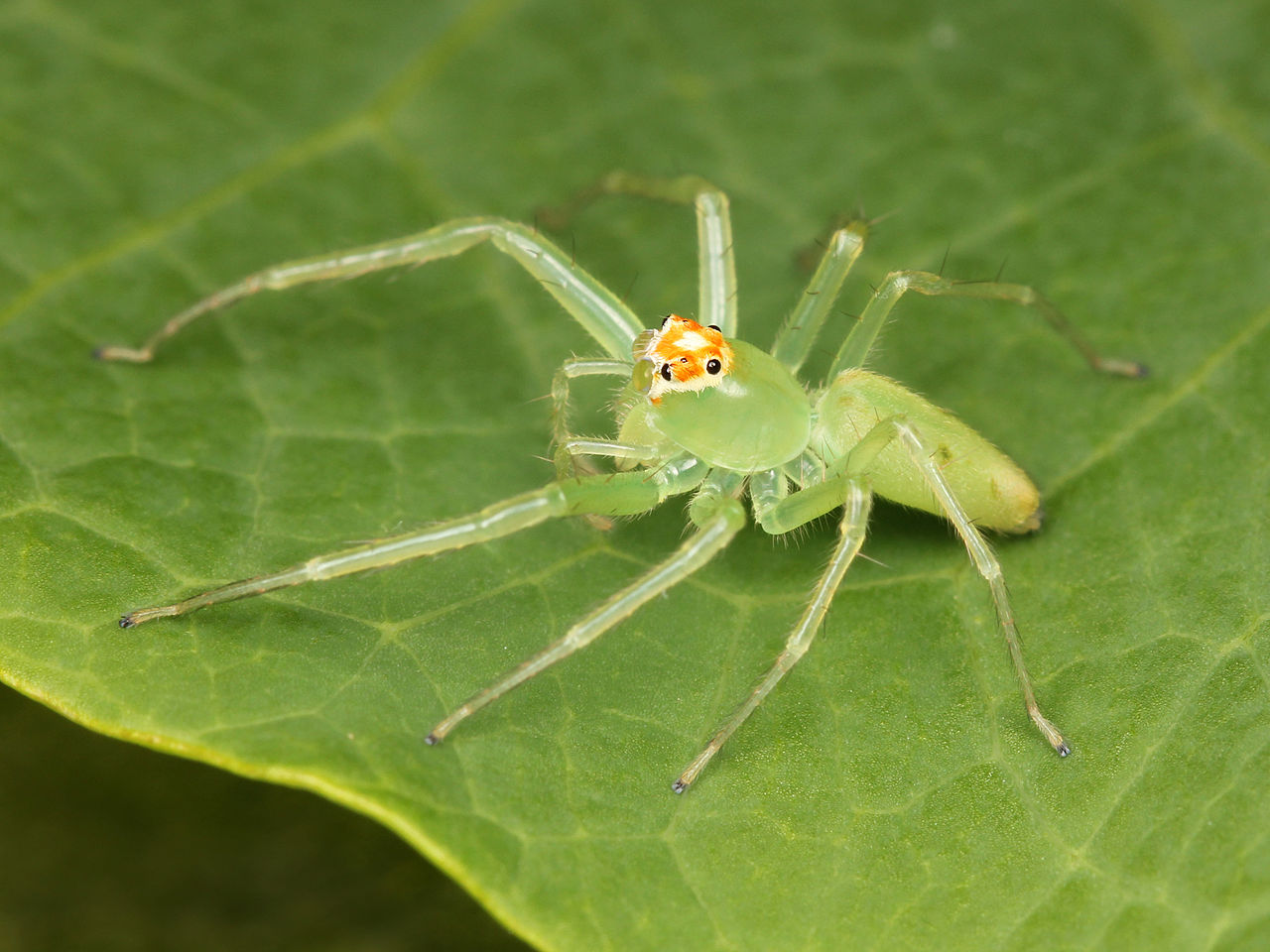
Scientific name: Lyssomanes viridis.
Common name: magnolia green jumper.
The magnolia green jumping spider is a small spider that is not furry and has long and slender legs, very different from the other jumping spiders you may come across.
Even with its thin and long legs, this spider can jump up to four times its body length and is an ambush hunter.
Females are larger than males with both having green bodies with black dots on the abdomen.
They are usually found in magnolia trees, along with maple, pine, and oak trees. They are mostly observed in warm and humid areas.
10. Dark Fishing Spider

Scientific name: Dolomedes tenebrosus.
Common name: dark fishing spider.
Dark fishing spiders are common in the United States and Canada and even though they are able to bite humans, they tend to run away and hide.
In the event, you do disturb or provoke the spider and it does bite, it is no worse than a bee sting.
The female, which can grow up to 26mm, is larger than the males, which grow up to 13mm. Their leg span can reach 90mm.
They are dark to light brown in color with chevron markings and light stripes on the legs. There are brown and black and red and brown bands on the legs.
They live in trees and are often observed in wooded areas.
11. Red-femured Spotted Orbweaver

Scientific name: Neoscona domiciliorum.
Common name: spotted orbweaver, redfemured spotted orbweaver.
The red-femured spotted orbweaver has white or yellow markings on the abdomen, which usually include black stripes on the side of a thin white band.
The first segment on the legs is red with the rest being black and pale gray banding. They have a dark underside with white spots and a red tip at the end of the abdomen.
Females can grow up to 26mm in length with sparse gray hairs, while the males grow to 8mm and have slender abdomens.
This orb weaver lives in woodland habitats.
12. Bold Jumping Spider

Scientific name: Phidippus audax.
Common name: daring jumping spider, bold jumping spider.
Bold jumping spiders belong to the Saliticidae family and are small spiders with the ability to jump four times their body length. The jumping allows them to ambush prey and escape predators.
As they jump in a rapid-fire pounce towards prey, they shoot out single silk, which reduces the risk of the prey escaping.
They are not easy to catch, making it unlikely you will get bitten. A bite is not harmful and causes a stinging sensation.
These are black spiders with a white line on the upper part of their abdomen and two white dots close to the back. They have white hairy patches on their legs and pedipalps.
They live in a variety of habitats including homes, cars, and offices.
13. American Nursery Web Spider

Scientific name: Pisaurina mira.
Common name: American Nursery Web Spider.
American nursery web spiders have the most dedicated mothers in the spider species.
The female carries her egg sac in her fangs as she carefully builds a nursery web, suspended inside a leaf or high in the weeds, where it is not visible and difficult to reach. The sac is covered in silk and then she stands guard until the eggs hatch.
They are ambush spiders with males looking different from females. Females are often seen in leaf litter carrying a sac with light brown to tan bodies and a dark streak that runs down the abdomen. Males are also light brown to tan with a lighter streak down the abdomen.
14. Arrowhead Orbweaver

Scientific name: Verrucosa arenata.
Common name: triangle orb weaver, arrowhead spider, arrowhead orbweaver.
Arrowhead orbweavers have an arrow-shaped abdomen that is pointy and triangular in shape, very different from the round-shaped abdomens of the rest of the orb-weaver family.
There is a white or yellow triangle at the top of the abdomen, which makes them easy to identify. The body is red to brown with varying shades for each individual.
They create their orb webs in shady areas and sit with their head up, rather than upside down.
They are mostly observed in the middle to late summer in wooded forests.
15. Canopy Jumping Spider

Scientific name: Phidippus otiosus.
Common name: Canopy Jumping Spider.
The canopy jumping spider mostly lives in trees with females being larger than the males, growing to around 16mm in body length.
They have bright-colored fangs which can range from green to red or purple.
These spiders are common in North Carolina, Texas, and Florida and there have been reports of them being exported with plants to European countries, such as Germany.
Further Reading:
16. Rabid Wolf Spider

Scientific name: Rabidosa rabida.
Common name: rabid wolf spider.
The harmless rabid wolf spider is not likely to bite, but due to its fast speed, large size, and name, there is a fear about these spiders.
They are fast-moving and erratic in their movements, which is where they go their names.
They do not have or carry Rabies and are completely harmless to humans.
They are aggressive and will challenge animals and people, though they do prefer to run away and hide. If you do get bitten by mistake, the bite is painful and will heal on its own without medical intervention.
They are light brown with two thick dark brown lines on the side of the head. They have one dark brown line on the abdomen with two thin lines on the sides.
17. Long-bodied Cellar Spider

Scientific name: Pholcus phalangioides.
Common name: daddy long-legs spider, long-bodied cellar spider, skull spider.
The long-bodied cellar spider, also known as the skull spider or daddy long legs, has a long and tubular shape that tapers at the waist.
They have long and skinny legs.
It is common to see these spiders bouncing in their web, which is to create a burring effect for any observers, disorientating predators. They hang upside down and wait for insects to get ensnared in their webs.
Their fangs are too small to inject venom into humans and are not considered poisonous or dangerous.
18. Golden Silk Spider

Scientific name: Trichonephila clavipes.
Common name: golden silk orb-weaver, golden silk spider, banana spider.
Golden silk spiders are part of the orb-weaver family with females being larger than males. Females are large and can grow up to 40mm in body length and are considered the largest orb-weaver species in the United States.
Females are also distinctive in color with a silver to white cephalothorax and orange to brown abdomen with white to yellow spots. Their abdomen color change as the spider gets older. They have dark yellow to brown banding on the legs.
Males grow to around 6mm in body length and are slender in build with a dark brown body and legs.
19. Spined Micrathena

Scientific name: Micrathena gracilis.
Common name: spined micrathena, castleback orbweaver.
The spined micrathena has pointed ridges on the abdomen of females, which makes them less appealing to predators. They are white, brown, and black in color, which is a great camouflage in the forest areas.
Males do not have spines and are more black or white in color with the slender abdomen.
Females wills it in the center of their webs waiting for prey to get ensnared.
They rebuild their webs daily and are mostly active in summer, where they can be observed in woods and forests.
20. White-banded Fishing Spider

Scientific name: Dolomedes albineus.
Common name: white-banded fishing spider.
White banded fishing spiders are part of the nursery web spider, where the female takes great care in protecting her eggs until they hatch.
They are found in the United States usually near streams and ponds.
Their hair is able to repel water, which gives the spider the ability to walk on water. They are also able to trap air on the abdomen, which enables it to swim and hunt for aquatic inverts and tadpoles.
21. Southern Black Widow

Scientific name: Latrodectus mactans.
Common name: southern black widow, simply black widow, shoe-button spider.
Female southern black widows have shiny black abdomens and cephalothorax with red markings. The red is an hourglass shape on the underside of the abdomen.
The male tends to be slender with white lines on the sides.
Females grow to around 3/8 of an inch, with males growing to 3/16 of an inch.
Only the mature female is capable of causing problems in humans if you are bitten. Females’ fangs that inject the venom are about 1mm in length, just enough to inject into a human.
They have an alpha-tatrotoxin which binds with the neuromuscular receptors. Deaths are very rare, even though there are approximately two thousand bites in the United States every year.
22. Six-spotted Fishing Spider
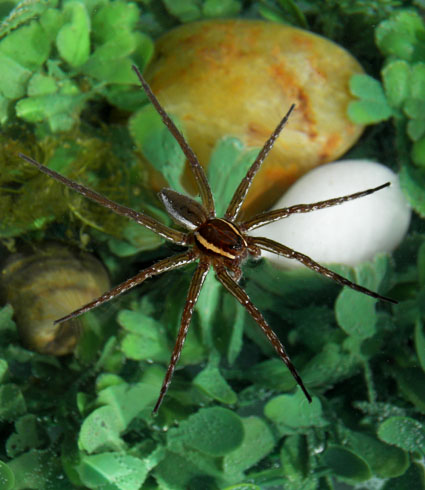
Scientific name: Dolomedes triton.
Common name: six-spotted fishing spider, dock spider.
Six spotted fishing spiders are nursery web spiders that are found in wetlands. They are mostly observed running on ponds or on other water.
These are large spiders with distinctive markings and eight eyes. The body is brown to gray in color with white to pale cream stripe on the sides of the cephalothorax.
Abdomens have light-colored spots with light-colored lines on the sides. There are also six dark spots on the base of the cephalothorax.
Females are larger than males, growing to 0.79 inches (20mm) in body length, with males growing to 0.51 inches (13mm) in body length.
23. Wolf Spider

Scientific name: Tigrosa annexa.
Common name: Wolf spider.
This spider belongs to the wolf spider species and is a sturdy spider that hunts for prey rather than building a web.
They have excellent eyesight and hunt at night.
The female is known for carrying her eggs and young with her.
They are not considered medically significant, even though they can give a painful bite that causes redness and swelling in the bite area, which can be managed with a cold compress at home.
24. Arrow-shaped Orbweaver
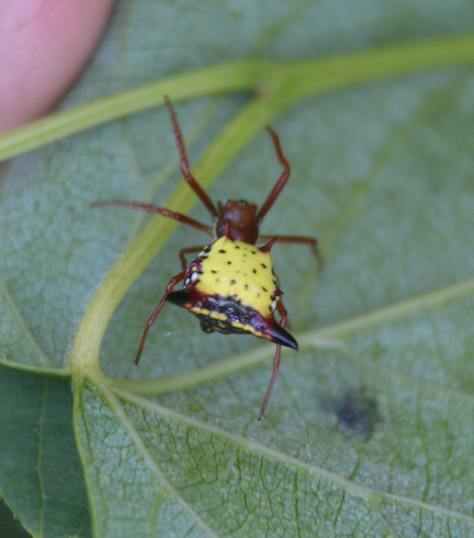
Scientific name: Micrathena sagittata.
Common name: arrow-shaped orbweaver.
The arrow-shaped orbweaver has a triangular-shaped abdomen.
Females have sharp spines that come out of the edge of the abdomen, which are believed to keep predators at bay. There are two large points that come from the base of the abdomen and tend to angle away from the other, they are red with black tips.
Males do not have any spines. While the male is black with white edges, females have a range of colors and patterns from the red head, legs, and body to the arrow-shaped abdomen with yellow and small red dots.
They are mostly observed in forested areas.
25. Eastern Parson Spider

Scientific name: Herpyllus ecclesiasticus.
Common name: eastern parson spider.
The Eastern Parson spider got its name from the abdominal marking that looks like a cravat that was worn by clergymen back in the 18th century.
They are common in North America and are often observed in forests, under rocks or logs, and in homes.
The Eastern Parson spider is covered in black hairs with gray hairs on the abdomen. They have a white mark on their back.
They are nocturnal and hunt at night.
They can give a painful bite with some people experiencing an allergic reaction. If you experience a bite and feel swelling in your face and throat, seek urgent medical treatment.
26. Southern House Spider

Scientific name: Kukulcania hibernalis (formerly Filistata hibernalis).
Common name: Southern house spider.
It’s not uncommon for homeowners to get the male Southern house spider and the brown recluse confused.
The tell-tale sign is that the southern house spider does not have a violin-shaped marking on its head.
The male is large and fast-moving. They wander around searching for a female and for prey.
Their spindly legs are what sets them apart from the female that has thicker legs and a more bulb-shaped body.
Females spend most of their time in their webs, while the males tend to wander.
27. Emerald Jumping Spider

Scientific name: Paraphidippus aurantius.
Common name: emerald jumping spider.
The emerald jumping spider is a solitary hunter that is large for a jumping spider with black and white stripes on the side of the head and a white border on the top of the abdomen.
These ambush spiders rely on their jumping ability to capture prey and escape predators.
They are not considered dangerous to humans, though they will bite if they are roughly handled, which can cause pain, swelling, and redness at the bite site.
28. Twin-flagged Jumping Spider

Scientific name: Anasaitis canosa.
Common name: twin-flagged jumping spider.
Twin-flagged jumping spiders have what you would think is the fifth pair of legs on the face, but they are used to help the spider sense its surrounding environment.
Each pedipalp has a white spot.
These spiders are mostly black in color with up to four white marks on the head plate, though they can vary slightly from one spider to eh next.
The abdomen comes to a pint at the tip with a white dash in the center.
They pounce on their prey, sending out a single strand of silk, which reduces the risk of their prey escaping.
29. Arabesque Orbweaver

Scientific name: Neoscona arabesca.
Common name: arabesque orbweaver.
Arabesque can be a beautiful and graceful ballet position or it is known for the architectural tiles seen in some Moorish buildings.
These spiders are variable in color with some being black, gray, brown, or orange. Females have a more bulb-like abdomen than the male, which are slender. They have short lines and curvy dashes on the center of the abdomen with black dashes on both sides.
They create circular webs between bushes, away from high traffic areas.
They are not aggressive and will try and escape if cornered.
30. Mabel Orchard Orbweaver

Scientific name: Leucauge argyrobapta.
Common name: Mabel’s orchard orb weaver.
The Mabel orchard orbweaver is a long-jawed orb weaver which belongs to the Tetragnathidea family of spiders.
Like the other orb weavers, it is able to create spectacular circular webs with a diameter of up to two meters. They sit in the center of the web, where they wait for prey to get entangled.
These are considered harmless to humans and a bite will cause pain, similar to that of a bee sting.
31. Furrow Orbweaver

Scientific name: Larinioides cornutus.
Common name: furrow spider, furrow orb weaver, foliate spider
The female furrow orbweaver can grow up to 14mm, while males are smaller, growing to around 9mm. They can reach 35mm in leg span.
They have an oval-shaped bulb abdomen in gray, black, or shades of red with a lighter shaded arrow on the carapace pointing towards the cephalothorax.
The legs have a similar arrow pattern.
They have eight eyes set in a horizontal row of six eyes with two above the central row.
They sense vibrations and sound through the tiny hairs on their legs.
They are mostly found near water, where they create their orb-shaped webs between grass and shrubs.
32. False Black Widow

Scientific name: Steatoda grossa.
Common name: cupboard spider, dark comb-footed spider, brown house spider (in Australia), false widow, false black widow.
The false black widow is easily mistaken as the black widow, except these are native to Europe and were brought to the United States.
They have white abdominal markings and grow to around 1cm in length when fully grown.
The false black window can bite, but it is not worse than being stung by a wasp.
33. Sylvan Jumping Spider

Scientific name: Colonus sylvanus.
Common name: Sylvan Jumping Spider.
Sylvan jumping spiders belong to the Salticidae family of jumping spiders and are found throughout the United States, all the way to Panama.
These small spiders use their exceptional jumping ability to ambush their prey and escape predators.
They are not easy to catch with their fast rapid-fire jumping, which means bites are very rare.
In the event you are bitten, the bite gives a stinging sensation and you may experience some redness and swelling for a day or two.
34. American Green Crab Spider

Scientific name: Misumessus oblongus.
Common name: American Green Crab Spider.
American green crab spiders have the ability to walk forwards, backward, and sideways, the same as their namesake.
They have long front legs which help them grab their prey from the flower they are hiding in. They are bright green and very small, enabling them to hide between the flower petals. Some have red banding on the side of their abdomen.
They do not spin webs to catch their prey, but are ambush predators and will climb plants searching for pollinating insects in flowers, fields, shrubs, and grass.
35. White-jawed Jumping Spider
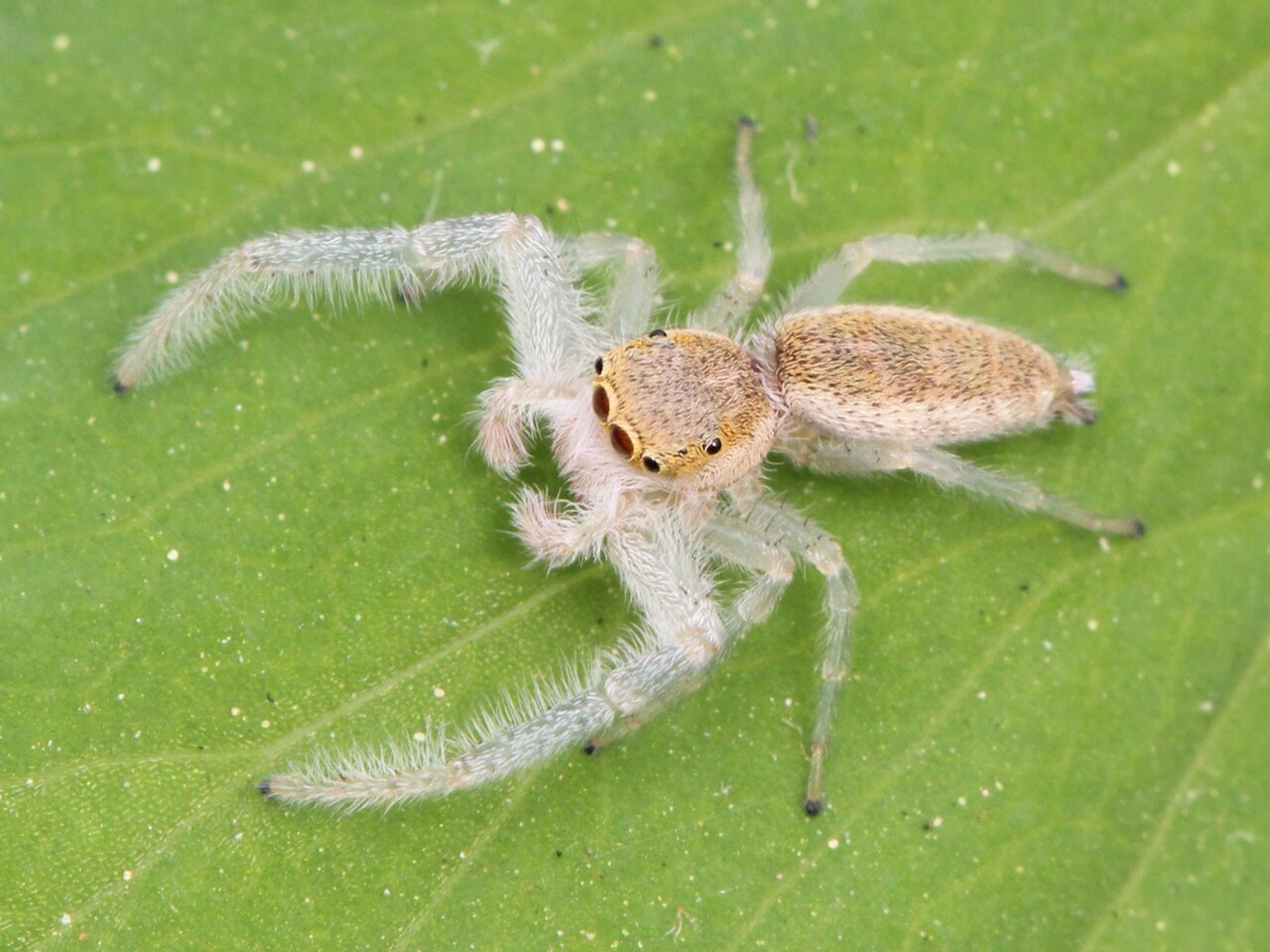
Scientific name: Hentzia mitrata.
Common name: white-jawed jumping spider.
White jawed jumping spiders can grow up to 3mm in length and are almost invisible due to their tiny size.
Males have bright red hairs on their heads, that look like a head dress.
They are copper in color. They are wanderers hunting for prey, using their excellent jumping abilities to ambush and capture their prey.
They are curious spiders and are not dangerous to humans, in fact, as long as you are gentle, they will be quite happy jumping across your fingers and hands.
36. White-banded Crab Spider

Scientific name: Misumenoides formosipes.
Common name: white banded crab spider.
The white-banded crab spider belongs to the Thornisidae family and has a white line that runs through their eyes.
They are sit-and-wait predators and capture pollinating insects when they visit plants where the spider is hiding.
They have strong front legs, which helps the spider capture their prey.
Females are larger than the male with partners that are variable with an overall color of between yellow and white, depending on where she is hiding.
Males don’t change color and have a gold abdomen with the four front legs being darker.
They have the ability to walk forwards, sideways, and backward, which is where they get their name.
37. Putnam’s Jumping Spider

Scientific name: Phidippus putnami.
Common name: Putnams jumping spider.
The Putnams jumping spider belongs to the Saliticidae family, which are able to jump four times their body length.
They have black hair above the eyes and on the sides of the head.
They ambush their prey and are not sit-and-wait predators. They do spin a web, which is used to hide and eat captured prey while giving the spider a safe place to retreat.
When they ambush prey, they shoot a single silk thread, which prevents the insect from escaping.
While they can sometimes make their way into the home, they are often found in open fields, gardens, parks, and forests.
They are not dangerous to humans.
38. Triangulate Combfoot

Scientific name: Steatoda triangulosa.
Common name: triangulate cobweb spider, triangulate bud spider.
The female triangulate combfoot can grow up to 6mm in length with brown to orange cephalothorax and yellow legs, that have small hairs. They have a bulb-shaped abdomen which is cream with purple to brown zigzag lines.
They spend hours each day developing their webs.
They are not considered medically significant and their bite is similar to that of a bee sting.
39. Basilica Orbweaver

Scientific name: Mecynogea lemniscata.
Common name: basilica orbweaver.
The basilica orbweaver has amazing colors, patterns, and abdominal shapes.
They have long abdomens with green, yellow, and orange, making them easy to see and identify. The side of the abdomen is green with white dots. The dorsal side is filled with orange lines over brown, black, or bright yellow and edged in white.
The neck looks like a cat’s eye.
They have green legs which have spiky hairs.
These spiders make dome-shaped webs, which are often seen in trees and holly shrubs.
You are most likely to observe the Basilica orbweaver from late spring to early summer.
40. Brilliant Jumping Spider

Scientific name: Phidippus clarus.
Common name: Brilliant jumping spider.
Brilliant jumping spiders belong to the Salticidae spider family and are often found in old fields, where they wait upside down at the top of the plant to detect prey, jumping down onto the prey.
They are small spiders where the male competes for the female. The male that produces the most vibrations on the surface wins, along with the larger-sized males. The successful males choose the largest females, which produce the most eggs.
They have a rectangular carapace and are red to brown in color, though there are some spiders that are brown or light yellow with dark markings.
41. Dimorphic Jumping Spider

Scientific name: Maevia inclemens.
Common name: Ribbon jumping spider.
The dimorphic jumping spider is a colorful jumping spider commonly observed in the United States where the males are in two forms.
The two forms are used for courting displays with the tufted morph having a black body and pedipalps with three black tufts on the head with pale legs, while the gray morph has black and white stripes over the legs and body with orange pedipalps and no tufts.
They are evenly separated and are both successful when it comes to mating.
Females are larger than males, growing to 0.31 inches (8mm) in body length, while males can grow to 0.256 inches (6.5mm).
They are commonly observed on man-made structures from buildings to fences, sheds, and barns.
42. Ribbon Jumping Spider

Scientific name: Metacyrba taeniola.
Common name: Ribbon jumping spider.
Ribbon jumping spiders belong to the Salticidae family with females growing slightly larger than the male. Females can grow to 0.28 inches (7.2mm) in body length, with males growing to 0.24 inches (6mm).
It is larger than some of the other jumping spiders with a large carapace.
These fast jumpers are able to leap four times their body length to ambush their prey or escape predators.
43. Garden Ghost Spider
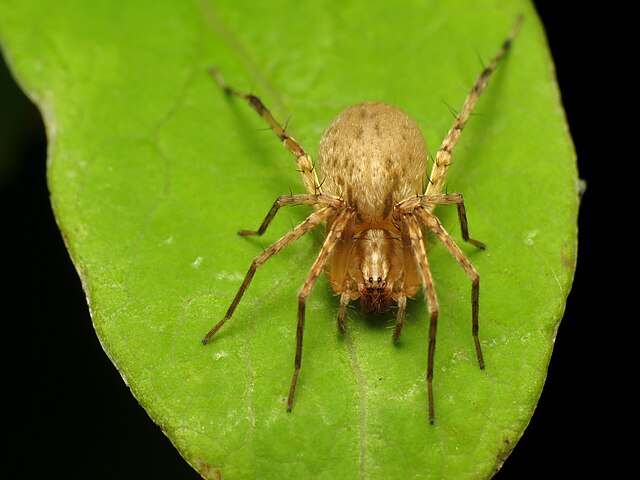
Scientific name: Hibana gracilis.
Common name: garden ghost spider.
The garden ghost spider belongs to the Anyphaenidae family with a body length of half an inch in length.
Their eight eyes are closely grouped with jaws that can move side to side.
The elongated abdomen is brown and yellow or beige and green with some dark markings, which may or may not be present.
They are hunters and do not rely on their web to ensnare their prey. They hide during the day in their webs, coming out at night to find their next meal.
They are harmless and their bite is similar to a bee sting. There may be some redness, pain, and swelling at the bite site, which will disappear over a day or two.
44. White Micrathena

Scientific name: Micrathena mitrata.
Common name: White Micrathena.
Micrathena is the Latin word for a head dress.
This spider has a white abdomen that comes to two sharp points at the rear and its head looks as though it is wrapped in a turban. There are two black patches on the abdomen with white specks and short dashes on both sides.
The cephalothorax is black to dark brown with the legs being lighter in color than the body that darken near the feet.
These small spiders hunt on plants and are considered beneficial for your garden.
45. Bowl-and-doily Spider
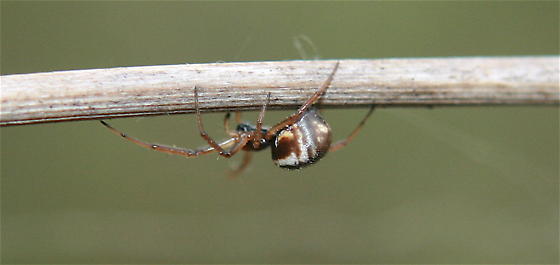
Scientific name: Frontinella pyramitela.
Common name: bowl-and-doily spider.
The bowl-and-doily spider is a member of the sheet weaver family, common in North Carolina.
It is a small spider which grows to around 0.16 inches (4mm) in length.
Their webs are complex and a sheet web system with an inverted dome, or bowl, which is suspended above the horizontal sheet or doily.
The spider then hangs upside down under the bowl where it bites through the web at small flies or other insects that fall into the webbing, which is not sticky. The webs usually have a male and female spider, where the webs are located in shrubs.
Further Reading: